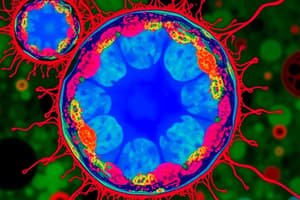Podcast
Questions and Answers
¿Cuál de las siguientes estructuras celulares es conocida como la 'central eléctrica' de la célula?
¿Cuál de las siguientes estructuras celulares es conocida como la 'central eléctrica' de la célula?
- Aparato de Golgi
- Mitocondria (correct)
- Lisosomas
- Núcleo
¿Qué orgánulo celular es responsable de la síntesis de proteínas, el almacenamiento de calcio y la síntesis de lípidos?
¿Qué orgánulo celular es responsable de la síntesis de proteínas, el almacenamiento de calcio y la síntesis de lípidos?
- Retículo endoplasmático (correct)
- Aparato de Golgi
- Lisosomas
- Núcleo
¿Cuál es la función principal del aparato de Golgi en una célula?
¿Cuál es la función principal del aparato de Golgi en una célula?
- Modificación de proteínas y lípidos (correct)
- Almacenamiento de calcio
- Síntesis de proteínas
- Descomposición de macromoléculas
¿Cuál es la función principal de los lisosomas en una célula?
¿Cuál es la función principal de los lisosomas en una célula?
¿Cuál es la función principal del núcleo en una célula eucariota?
¿Cuál es la función principal del núcleo en una célula eucariota?
¿Qué orgánulo celular se conoce como el 'controlador' de una célula eucariota?
¿Qué orgánulo celular se conoce como el 'controlador' de una célula eucariota?
¿Quiénes propusieron la teoría celular por primera vez en 1839?
¿Quiénes propusieron la teoría celular por primera vez en 1839?
¿Cuál es la principal diferencia entre las células procariontes y eucariontes?
¿Cuál es la principal diferencia entre las células procariontes y eucariontes?
¿Qué estructura celular es común en células eucariontes pero no en procariontes?
¿Qué estructura celular es común en células eucariontes pero no en procariontes?
¿Cuál es la función principal de los organelos celulares?
¿Cuál es la función principal de los organelos celulares?
¿Qué tipo de células son las que presentan una organización en compartimentos con organelos rodeados por membranas?
¿Qué tipo de células son las que presentan una organización en compartimentos con organelos rodeados por membranas?
¿Qué término se utiliza para describir el proceso mediante el cual las células eucariontes contienen organelos que alguna vez fueron organismos independientes?
¿Qué término se utiliza para describir el proceso mediante el cual las células eucariontes contienen organelos que alguna vez fueron organismos independientes?
Study Notes
Cells: An Introduction
Cells form the basic structure and functioning units of all living organisms, from simple bacteria to multi-cellular beings like humans. The term 'cell' comes from the Latin word for "room," reflecting their role as the structural and functional units of life. The study of cells is known as cell biology or cytology and is essential to various branches of biology, including genetics and molecular biology.
Cell Theory: A Foundational Concept
The cell theory proposes that all living organisms are composed of one or more cells and that these cells are the fundamental unit of life. This theory also states that cells arise from pre-existing cells through a process called division and that they perform all biological functions necessary for an organism's existence. Scientists Matthias Schleiden and Theodor Schwann first proposed this theory in 1839.
Prokaryotic vs Eukaryotic Cells
Cells can be classified into two main categories based on the presence or absence of a nucleus enclosed by a membrane. Prokaryotic cells do not have a nucleus or other membrane-bound organelles, while eukaryotic cells (found in plants and animals) contain a true nucleus surrounded by nuclear membranes and various specialized organelles that perform specific functions.
Cellular Structures and Functions: Organelles and their roles
Eukaryotic cells are organized into several compartments enclosed in their own lipid bilayer membranes, which we call organelles. These structures play diverse roles in cellular processes such as protein synthesis, energy production, signal transduction, DNA replication and repair, chromatin biology/gene regulation, RNA processing/splicing/modification, mitochondria biology, and glycobiology. Some key organelles include:
Nucleus
This is the control center of a eukaryotic cell, housing genetic information stored as DNA. It also performs essential tasks like regulating gene expression through DNA replication, transcription, and translation.
Mitochondrion
Known as the "powerhouse" of a cell, mitochondria generate most of the ATP (adenosine triphosphate), an energy currency molecule, necessary for cellular activities. They also participate in other crucial physiological processes.
Endoplasmic reticulum (ER)
The ER is responsible for protein synthesis, calcium storage, and lipid synthesis. Two types of ER – smooth endoplasmic reticulum (SER) and rough endoplasmic reticulum (RER) – serve different functions within the cell.
Golgi apparatus
It modifies proteins and lipids produced inside the cell by various organelles, directing them to their correct destinations within the cell.
Lysosomes
These membrane-bound vesicles contain digestive enzymes that break down macromolecules and foreign particles in the cell, ensuring efficient waste removal and recycling of materials.
Understanding these structures and their functions allows us to comprehend the complex workings of life at the cellular level.
Studying That Suits You
Use AI to generate personalized quizzes and flashcards to suit your learning preferences.
Description
Descubre la importancia de las células como unidades fundamentales de los organismos vivos, desde bacterias simples hasta seres multicelulares. Aprende sobre la teoría celular, la diferencia entre células procariontes y eucariontes, y la función de organelos clave como el núcleo, la mitocondria, el retículo endoplasmático, el aparato de Golgi y los lisosomas.



